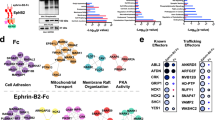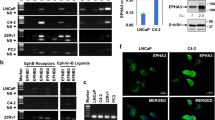Abstract
Eph tyrosine kinase receptors and their membrane-bound ephrin ligands mediate cell interactions and participate in several developmental processes1,2,3,4. Ligand binding to an Eph receptor results in tyrosine phosphorylation of the kinase domain, and repulsion of axonal growth cones and migrating cells. Here we report that a subpopulation of ephrin-A5 null mice display neural tube defects resembling anencephaly in man. This is caused by the failure of the neural folds to fuse in the dorsal midline, suggesting that ephrin-A5, in addition to its involvement in cell repulsion5,6, can participate in cell adhesion. During neurulation, ephrin-A5 is co-expressed with its cognate receptor EphA7 in cells at the edges of the dorsal neural folds. Three different EphA7 splice variants7,8, a full-length form and two truncated versions lacking kinase domains, are expressed in the neural folds. Co-expression of an endogenously expressed truncated form of EphA7 suppresses tyrosine phosphorylation of the full-length EphA7 receptor and shifts the cellular response from repulsion to adhesion in vitro. We conclude that alternative usage of different splice forms of a tyrosine kinase receptor can mediate cellular adhesion or repulsion during embryonic development.
This is a preview of subscription content, access via your institution
Access options
Subscribe to this journal
Receive 51 print issues and online access
$199.00 per year
only $3.90 per issue
Buy this article
- Purchase on Springer Link
- Instant access to full article PDF
Prices may be subject to local taxes which are calculated during checkout




Similar content being viewed by others
References
Flanagan, J. G. & Vanderhaegen, P. The ephrins and Eph receptors in neural development. Annu. Rev. Neurosci. 21, 309–345 (1998).
Frisén, J., Holmberg, J. & Barbacid, M. Ephrins and their eph receptors: multitalented directors of embryonic development. EMBO J. 18, 5159 –5165 (1999).
Holder, N. & Klein, R. Eph receptors and ephrins: effectors of morphogenesis. Development 126, 2033– 2044 (1999).
O'Leary, D. D. M. & Wilkinson, D. G. Eph receptors and ephrins in neural development. Curr. Opin. Neurobiol. 9, 65–73 (1999).
Drescher, U. et al. In vitro guidance of retinal ganglion cell axons by RAGS, a 25 kDa tectal protein related to ligands for Eph receptor tyrosine kinases. Cell 82, 359–370 (1995).
Frisén, J. et al. Ephrin-A5 (AL-1/RAGS) is essential for proper retinal axon guidance and topographic mapping in the mammalian visual system. Neuron 20, 235–243 ( 1998).
Ciossek, T., Millauer, B. & Ullrich, A. Identification of alternatively spliced mRNAs encoding variants of MDK1, a novel receptor tyrosine kinase expressed in the murine nervous system. Oncogene, 10, 97– 108 (1995).
Valenzuela, D. M. et al. Identification of full-length and truncated forms of Ehk-3, a novel member of the Eph receptor tyrosine kinase family. Oncogene 10, 1573–1580 ( 1995).
Botto, L. D., Moore, C. A., Khoury, M. J. & Erickson, J. D. Neural-tube defects. N. Engl. J. Med. 341, 1509–1519 (1999).
Källén, B. et al. International study of sex ratio and twinning of neural tube defects. Teratology 50, 322– 331 (1994).
Fleming, A. & Copp, A. J. Embryonic folate metabolism and mouse neural tube defects. Science 280, 2107–2109 (1998).
Pandey, A., Shao, H., Marks, R. M., Polverini, P. J. & Dixit, V. M. Role of B61, the ligand for the Eck receptor tyrosine kinase, in TNF-a-induced angiogenesis. Science 268, 567–569 (1995).
Castellani, V., Yue, Y., Gao, P.-P., Zhou, R. & Bolz, J. Dual action of a ligand for Eph receptor tyrosine kinases on specific populations of axons during the development of cortical circuits. J. Neurosci. 18, 4663–4672 ( 1998).
Gao, P.-P., Sun, C.-H., Zhou, X.-F., DiCicco-Bloom, E. & Zhou, R. Ephrins stimulate or inhibit neurite outgrowth and survival as a function of neuronal cell type. J. Neurosci. Res. 60, 427–436 (2000).
Davy, A. et al. Compartmentalized signaling by GPI-anchored ephrin-A5 requires the Fyn tyrosine kinase to regulate cellular adhesion. Genes Dev. 13, 3125–3135 ( 1999).
Orioli, D., Henkemeyer, M., Lemke, G., Klein, R. & Pawson, T. Sek4 and Nuk receptors cooperate in guidance of commissural axons and in palate formation. EMBO J. 15, 6035–6049 ( 1996).
van der Geer, P., Hunter, T. & Lindberg, R. A. Receptor protein-tyrosine kinases and their signal transduction pathways. Annu. Rev. Cell Biol. 10, 251–337 (1994).
Xu, Q. L., Alldus, G., Holder, N. & Wilkinson, D. G. Expression of truncated Sek-1 receptor tyrosine kinase disrupts the segmental restriction of gene expression in the Xenopus and zebrafish forebrain. Development 121, 4005–4016 ( 1995).
Xu, Q., Alldus, G., Macdonald, R., Wilkinson, D. G. & Holder, N. Function of the Eph-related kinase rtk1 in patterning of the zebrafish forebrain. Nature 381, 319–322 (1996).
Nakamoto, M. et al. Topographically specific effects of Elf-1 on retinal axon guidance in vitro and retinal mapping in vivo. Cell 86, 755–766 (1996).
Holland, S. J., Peles, E., Pawson, T. & Schlessinger, J. Cell-contact-dependent signalling in axon growth and guidance: Eph receptor tyrosine kinases and receptor protein tyrosine phosphatase beta. Curr. Opin. Neurobiol. 8, 117–127 ( 1998).
Zou, J. X. et al. An Eph receptor regulates integrin activity through R-Ras. Proc. Natl Acad. Sci. USA 96, 13813– 13818 (1999).
George, S. E., Simokat, K., Hardin, J. & Chisholm, A. D. The VAB-1 Eph receptor tyrosine kinase functions in neural and epithelial morphogenesis in C. elegans. Cell 92, 633– 643 (1998).
Song, H. et al. Conversion of neuronal growth cone response from repulsion to attraction by cyclic nucleotides. Science 281, 1515–1518 (1998).
Hong, K. et al. A ligand-gated association between cytoplasmic domains of UNC5 and DCC family receptors converts netrin-induced growth cone attraction to repulsion. Cell 97, 927– 941 (1999).
Henrique, D. Expression of a Delta homologue in prospective neurons in the chick. Nature 375, 787–790 (1995).
Cheng, H.-J. & Flanagan, J. G. Identification and cloning of Elf-1, a developmentally expressed ligand for the Mek4 and Sek receptor tyrosine kinases. Cell 79, 157–168 (1994).
Ciossek, T., Ullrich, A., West, E. & Rogers, J. H. Segregation of the receptor EphA7 from its tyrosine kinase-negative isoform on neurons in adult mouse brain. Brain Res. Mol. Brain Res. 74 , 231–236 (1999).
Wang, H. U. & Anderson, D. J. Eph family transmembrane ligands can mediate repulsive guidance of trunk neural crest migration and motor axon outgrowth. Neuron 18, 383– 396 (1997).
Wikström, K., Kjellström, G. & Öbrink, B. Homophilic intercellular adhesion mediated by C-CAM is due to a domain 1-domain 1 reciprocal binding. Exp. Cell Res. 227, 360–366 ( 1996).
Acknowledgements
We thank M. Barbacid, J. Ericson, J. Flanagan, U. Lendahl, B. Öbrink, L. Philipson, D. Wilkinson and members of our laboratory for helpful discussions; S. Park for help with vector construction; T. Ciossek for EphA7 cDNAs and antisera; J. Wasserman for assistance with scanning electron miscroscopy; and B. Singer and G. Greicius for help with FACS analysis. This study was supported by grants from the Swedish Foundation for Strategic Research, the Karolinska Institute, the Swedish Medical Research Council, the Swedish Cancer Society, the Swedish Medical Society, Hedlunds stiftelse, Ostermans stiftelse, Magnus Bergvalls stiftelse, Marcus Borgströms stiftelse, Hagbergs stiftelse, Tore Nilssons stiftelse, the Wenner-Gren foundation, Åke Wibergs stiftelse and Kapten Arthur Erikssons fond. D.L.C. was supported by a Wenner-Gren postdoctoral fellowship.
Author information
Authors and Affiliations
Corresponding author
Rights and permissions
About this article
Cite this article
Holmberg, J., Clarke, D. & Frisén, J. Regulation of repulsion versus adhesion by different splice forms of an Eph receptor. Nature 408, 203–206 (2000). https://doi.org/10.1038/35041577
Received:
Accepted:
Issue Date:
DOI: https://doi.org/10.1038/35041577
This article is cited by
-
The role of EphA7 in different tumors
Clinical and Translational Oncology (2022)
-
Association between rare variants in specific functional pathways and human neural tube defects multiple subphenotypes
Neural Development (2020)
-
Ephrin-A5 potentiates netrin-1 axon guidance by enhancing Neogenin availability
Scientific Reports (2019)
-
Eph receptor signalling: from catalytic to non-catalytic functions
Oncogene (2019)
-
Mechanisms of ephrin–Eph signalling in development, physiology and disease
Nature Reviews Molecular Cell Biology (2016)
Comments
By submitting a comment you agree to abide by our Terms and Community Guidelines. If you find something abusive or that does not comply with our terms or guidelines please flag it as inappropriate.



